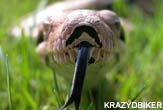Night Vision: How Snakes Get Clear Picture of Prey

Without a trip to an eye doctor, some snakes have developed their own vision-correcting devices. Scientists have discovered how pit vipers can turn blurry blobs into useful images with striking clarity.
Turns out it's all in their tiny minds.
Two groups of snakes, pit vipers and boids (a family that includes boa constrictors) sport a pit organ on either side of their heads. Stretched across each pencil-eraser-size cavity is a membrane that can detect infrared light—which is heat—emitted by nearby prey. Scientists have known that pit vipers utilize these organs similar to the way a pinhole camera works.
The "pithole" acts like a lens, forcing light from the source to form a tiny point on the membrane—the camera's film. By focusing the light to such a tiny point, pinhole cameras can produce crisp images.
"So to get a clear image you would need a pinhole camera with a really small hole," explained Leo van Hemmen, a physicist at the Technical University of Munich in Germany.
But an aperture so tiny would never let in enough infrared waves, which have a much lower frequency than visible light, to stimulate the membrane. The tiny aperture "means a small amount of energy per second, far too small to excite even sensitive [infrared] detectors in the pit membrane," van Hemmen explained.
The pit openings of the snake are too large, therefore, to produce crisp images.
Sign up for the Live Science daily newsletter now
Get the world’s most fascinating discoveries delivered straight to your inbox.
Using a computer model, van Hemmen's team found that some snakes rely on a network of neurons in their brains to bring a blurry image into view. The brain network serves effectively as corrective lenses, the study indicates.
The results will be detailed in an upcoming issue of the journal Physical Review Letters.
The model showed that an infrared signal from each of the membrane's heat receptors triggers a neuron to fire. This firing rate varies with respect to input from the other receptors. By fine-tuning how the approximately 2,000 heat receptors interact, van Hemmen's team created strike-worthy images [Example].
Sharp images are crucial for a hungry snake "if it wants to hit a point source, say, a small mouse at a distance of 1 meter [3 feet]," van Hemmen told LiveScience.
None of this is overly complex, either. Snakes have small brains, so the researchers kept their computer model simple, concluding that "even a crude network dramatically improves infrared imaging."
Jeanna Bryner is managing editor of Scientific American. Previously she was editor in chief of Live Science and, prior to that, an editor at Scholastic's Science World magazine. Bryner has an English degree from Salisbury University, a master's degree in biogeochemistry and environmental sciences from the University of Maryland and a graduate science journalism degree from New York University. She has worked as a biologist in Florida, where she monitored wetlands and did field surveys for endangered species, including the gorgeous Florida Scrub Jay. She also received an ocean sciences journalism fellowship from the Woods Hole Oceanographic Institution. She is a firm believer that science is for everyone and that just about everything can be viewed through the lens of science.










